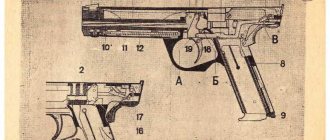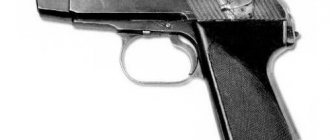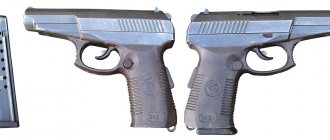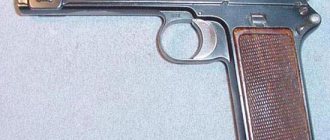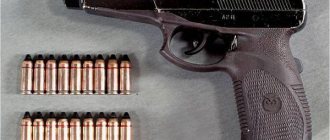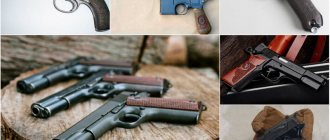Lahti L-35. Finnish Winter War pistol
By the end of 1939, when the Soviet-Finnish war began, the Finnish army was armed mainly with small arms of its own production. For example, the Finnish Suomi submachine gun, which looks very much like the famous Shpagin submachine gun, became one of the symbols of that war. Much less people know about Finnish pistols of that period. One of them was the L-35 semi-automatic (self-loading) pistol designed by Aimo Lahti. This pistol was the personal weapon of officers of the Finnish army, and Aimo Lahti himself is rightfully recognized by his contemporaries as the father of Finnish small arms of the 1920-1930s.
Aimo Lahti began work on an eight-round pistol chambered for the German 9×19 mm Parabellum cartridge back in 1929. The weapon was adopted by the Finnish army in 1935. At the same time, the rate of its production was quite low. By the beginning of the Winter War, only 500 L-35 pistols were manufactured in Finland. It is worth noting that this is the only “polar pistol” in the world. The weapon was specially created by Lahti for use in conditions of low temperatures and possible icing.
Quite often, at the first glance at the Finnish L-35 pistol, all firearms lovers immediately have associations with the more famous German Luger P.08. Indeed, these two pistols are very similar in appearance, but this is where their similarities practically end. When creating his L-35 pistol, Aimo Lahti paid a lot of attention to ensuring the reliability of the weapon in harsh northern conditions: the mechanics of the pistol are reliably protected from the ingress of water and dirt, which at low temperatures could lead to failures and the impossibility of using the pistol. Also, to increase its reliability, a bolt accelerator was used in the design of the L-35. Experts considered the main advantages of this model to be an easy trigger and low recoil when fired.
In its homeland, the L-35 pistol was produced in relatively small quantities, the total production was only about 9 thousand copies, production was completely stopped after the end of World War II. At the same time, this rather successful pistol turned out to be in demand in neighboring Sweden, where about 90 thousand pistols called Lahti Husqvarna m/40 were produced in 1940-1946. The changes compared to the Finnish pistol were minor. Thrifty Swedes used this weapon for a very long time; the pistol remained in service until the 1980s.
It should be noted that by the end of the 1920s, the Finnish army was armed with pistols and revolvers of a wide variety of calibers and systems. There were also Nagans inherited from the Russian tsarist army, Belgian Bergman-Bayard pistols, as well as German Parabellum pistols. Realizing that the military needed a single pistol, adapted for use in fairly harsh conditions, Lahti set about creating a pistol that would meet the requirements of the Finnish army: simplicity of design, high reliability, ease of assembly and disassembly, ability to pierce a German steel helmet at a distance of 50 meters . Even then, the pistol was compared to the Luger P.08, which was in service with the Finnish army. Externally, the pistols were similar due to the large angle of the handle and the open barrel, but the design of the two pistols was different.
The main feature of the Finnish pistol Lahti L-35 was a completely bare (open) barrel. This form of weapon originates from the Borchardt model, which he introduced back in 1893. And although already in the 20th century Browning pistols with a barrel that was covered with a bolt (shroud-shroud) began to become widespread, the shape of the pistol with a protruding barrel continued to attract the attention of designers around the world. For example, in 1925, a pistol created by Kiyiro Nambu entered service with the Japanese army. This was facilitated by the very great popularity of the Georg Luger pistol, the features of which he inherited.
The L-35 pistol was also known among the Finnish military as Suomi-pistooli and Lahti-pistooli. At the same time, the weapon did not turn out quite the way the military imagined it. The pistol was quite heavy and large, but it was very comfortable to hold and shoot from, it was easy to control, and the shooting accuracy was very high. The weapon was also highly reliable, including at extremely low ambient temperatures. But despite all this, the L-35 pistol was also quite difficult to maintain. In order to disassemble, clean and reassemble a pistol, its owner had to have training and certain skills, and only a highly qualified craftsman could make repairs in the event of a pistol breakdown. However, in fairness, it should be admitted that the pistol broke very rarely, and it was made from very good high-quality weapon steel. The Lahti L-35 was produced at a very slow pace, partly due to manual finishing and assembly of the weapon.
The Lahti L-35 pistol was an example of a self-loading weapon, built on the basis of an automatic weapon with a short barrel stroke. The barrel of the pistol was rigidly connected to the receiver of rectangular cross-section, and the bolt (also of rectangular cross-section) moved inside it. The bolt and receiver were locked using a “U”-shaped latch, which was movable in a vertical plane. In the first moments of the shot, the barrel of the pistol, along with the receiver and bolt, rolled back a few millimeters, after which the latch, interacting with the frame, rose up and released the bolt. The barrel stopped, transferring kinetic energy to the bolt through a special part in the L-35 design - the bolt accelerator. For manual reloading of the pistol, two grooved finger grips were located at the rear of the bolt, which protruded behind the receiver. On the upper surface of the L-35 receiver, in a special boss, there was an indicator of the presence of a cartridge in the chamber. The window for ejecting cartridges was located on the right side of the receiver; in the normal position it was closed from the inside by the bolt body. The ejector was spring-loaded and was located in the left wall of the receiver.
The trigger mechanism of the pistol had a hidden trigger, which was located inside the frame, due to which the firing pin does not run parallel to the axis of the barrel, but at an upward angle to the shutter mirror. The Lahti L-35 pistol was equipped with a safety lever that blocked the trigger mechanism; the safety was located on the left side of the frame. The weapon turned out to be quite massive and even exceeded the famous Mauser K-96 in weight without ammunition. The grip cheeks on the L-35 pistols of the first series were made of beech; later they were replaced with plastic elements.
The L-35 pistol was produced in Finland in four main series. Zero was produced back in 1938 and was intended primarily for army testing. The first series, in which about 2,600 pistols were produced, was produced from March 1940 to July 1941 and was distinguished by the presence of a figured protrusion on the upper rear part of the receiver. From August 1941 to March 1942, the second series of pistols was produced - about 1000 copies; these pistols did not have a figured protrusion on the receiver, and the geometry of the locking wedge was modified. The third series, which consisted of more than 2,000 copies, was produced from April to September 1944. The pistols of this series did not have a recoil accelerator, and the receiver received a slightly different shape. The last batch of approximately 1,000 pistols was manufactured already in 1945 from stocks of remaining parts.
The Swedish Lahti Husqvarna m/40 pistols differed from the Finnish ones in a number of parameters. Firstly, purely visually, they had an enlarged trigger guard, a slightly longer barrel, as well as a groove on the handle intended for attaching a holster-butt. Secondly, Swedish pistols did not have an indicator of the presence of a cartridge in the chamber. Thirdly, they did not use a shutter accelerator (for reasons of reducing the cost of pistol production), which, in turn, somewhat reduced the reliability of its automation.
Tactical and technical characteristics of the L-35: Caliber - 9 mm. Cartridge - 9x19 mm Parabellum. Length - 245 mm. Barrel length - 107 mm. Weight - 1.2 kg. Magazine capacity - 8 rounds.
Sources of information: https://www.dogswar.ru/strelkovoe-oryjie/pistolety-revolvery/145-pistolet-llahti-l-35.html https://www.armoury-online.ru/articles/pistols/finland/ lahti https://warspot.ru/5695-lahti-pistolet-dlya-zimney-voyny Materials from open sources
Combat use
The Lahti L-39 proved effective in combat operations on the Soviet-Finnish front.
Taking advantage of the difficult terrain conditions, the Finns staged successful ambushes on Soviet troops. It allowed such maneuverable groups to fight lightly armored Soviet armored vehicles. The L-39 was a relatively portable weapon that the Finns put to good use besides shooting at armored vehicles. The 20mm high-explosive round worked well against bunkers and trucks. In addition, this anti-tank rifle was also used as an anti-sniper weapon. The dummy of a Finnish army officer was positioned so that the Soviet sniper could see it. The sniper fired a shot, unmasking his position, at which a shot was fired from the Lahti L-39.
During the second Soviet-Finnish War, the Lahti L-39 was no longer effective against Soviet medium tanks T-34 and heavy KV-1, but the anti-tank rifle was successfully used against various field fortifications and embrasures. Later, a number of guns were adapted as light anti-aircraft guns.
story
Following Finnish independence from Russia in 1917 and the defeat of the Finnish Red Guard during the Finnish Civil War, Finland began the process of replacing its outdated Russian weaponry. Efforts to modernize Finland's arsenal included replacing Russian Nagant M1895 revolvers with Spanish Ruby Pistols purchased from France in 1919 and later German P08 Luger purchased from Deutsche Waffen und Munitionsfabriken in 1923. Finland began to set out to autonomously produce its own weapons with the Finnish Volunteer Guards opening the arsenal. , Suojeluskuntain ase- JA Konepaja Oy (SAKO) in 1921, and the Finnish government opening the Valtion Kivääritehdas (VKT) in Jyväskylä in 1929. The Finnish army soon called for domestic production of a pistol that could withstand Finland's harsh winter. Design began in 1929 under the direction of Aimo Lahti and a patent was issued for the M1935 Lahti pistol in 1935. The Lahti was originally designed to fire stockpiled 7.65×21mm Parabellum and 9×19mm Parabellum ammunition but was ultimately limited to only 9mm. The Lahti pistol became officially adopted in 1935 by the Finnish Armed Forces as the Pistooli L-35. Production was slow for widespread use with only 500 pistols completed before production was stopped at the start of the Winter War. Production continued into 1941 with approximately 4,500 pistols manufactured before production was interrupted again as the war continued. Final production of Finnish Lahti pistols resumed again in 1946, with about 9,000 completed until 1951.
design
The M1935 Lahti is considered well made and finished. Although the Lahti is similar in appearance to the P08 Luger (and shares a barrel thread with the same), the firing mechanism is significantly different and more closely related to the Bergmann-Bayard pistol. The Lahti is a recoil-controlled, single-action, closed breech firearm mounted with a hidden hammer. The pistol itself is well sealed against dirt and ice, but heavy by modern standards. A safety guide was provided by a lever on the left side of the pistol. It is impossible to detach and clean the Lahti without a qualified armorer or access to a workshop, but the need for repairs in the area was rare due to the robust design of the Lahti.
Bolt accelerator
The addition of an accelerator bolt to the Lahti pistol was intended to ensure the pistol's performance in arctic conditions in Finland. Bolt Accelerators are more commonly found in machine guns to increase the rate of fire. The bolt accelerator in Lahti works by having a crank lever to strike the gun's bolt as it unlocks from firing. This pushes the bolt mechanically instead of relying on the firing impulse alone to move the bolt. The amount of accelerator bolt addition was an issue with a batch of guns made without the accelerator being produced. The immediate recall of pistols without bolt accelerators is believed to indicate that the accelerator is not essential but useful in the operation of the gun.
Options and modifications
- Lahti L-35
- Finnish-made pistols, mass-produced at the armory from 1938 to 1952. - Husqvarna M/40
are Swedish-made pistols, produced at the Husqvarna Vapenfabrik AB arms factory from 1940 to 1946. A total of 83,950 units were produced. The M-40 had a longer barrel than the L-35 and did not have a cartridge indicator. On some Swedish versions, the shape of the trigger guard has been changed, and sometimes there is no recoil accelerator. Due to the more powerful version of the 9x19 cartridge used in the Swedish army, pistols often failed - cracks appeared in the locking unit.
Lahti Husqvarna m/40
Husqvarna Model 40, Swedish copy of Lahti
The Husqvarna Model 40 or m/40 was manufactured 1940 to 1946 and was a Swedish copy of the Finnish Lahti pistol. The Swedish army realized that there would be a shortage of pistols in the event of a large-scale military mobilization in Europe. Initially adopting the P38 Walther in 1939, Germany's entry into World War II stopped the export of P38s to Sweden. To compensate, Sweden accepted the Lahti pistol, but was unable to import L-35 type guns due to Finland's conflicts with the USSR. The product was licensed to Svenska AB Automatvapen, but the company's immediate collapse was a contract to Husqvarna Vapenfabriks. The first M/40s were delivered to the Swedish military by 1942 with minor differences from the Finnish L-35 Lahtis. The grips on the m/40 have the Husqvarna "Crown H" motif engraved and the front sight was slightly larger. The barrel is also slightly longer at m/40 than the Finnish Lahti's m/40 – the trigger is heavier, and the pistol does not have a loaded indicator chamber and locks holding the Finnish Lahti's spring. Other modifications included changes to the gun steel quality specification, which were not successful in the M/40s and resulted in cracks in the frame. The cracking in the frame became more aggravated as the ammunition developed for use in the Carl Gustav M/45 Submachine Gun was used in pistols. The M/40 would eventually be phased out in the 1980s due to frame cracks, being completely replaced by the Glock 17 in the early 1990s.
Description
The Lahti L-35 pistol is built on an automatic system that operates due to a short barrel stroke; the bolt is locked by a cylinder moving in a vertical groove. The trigger mechanism is of the hammer type, the trigger is completely closed by the bolt. The mainspring is located in the handle, the return spring is inside the bolt. The safety box is located on the right side, behind the pistol grip; when turned on, it blocks the trigger. Most pistols have a groove for attaching a holster-stock, including the “Mauser” type, of which only about two hundred copies were produced. On the back side of the pistol frame there is a swivel for attaching a cord. The sights on early pistols were not adjustable, but later the front sight became adjustable. The grip cheeks on pistols of the first releases were made of beech, while on later ones they were made of plastic.
Pistol LAMPO "LAMPO" (ITALY)
The design of this repeating pistol - one of many pistols of this type developed at the end of the 19th century - was patented by Catello Tribuzio of Turin in 1890. Unlike other contemporary models of a similar design, the “lampo” was in demand, although quite moderate.
Its handle, deeply concave at the rear and straightened at the front, accommodated a replaceable box magazine. A barrel with a receiver was mounted on top, and a trigger with a ring protruded in front of the handle. When the trigger was moved forward, the bolt associated with it opened; it closed when the trigger returned to its original position, sending an 8 mm Gaulois cartridge from the magazine into the chamber along the way. Further pressing of the trigger fired a shot.
Design
The Lahti L-39 is designed on the basis of an automatic aircraft cannon. The gun's automation operates on the principle of removing powder gases through a side hole in the barrel wall. A corresponding closed-type gas chamber is installed under the barrel at a distance of approximately half the length of the barrel from its muzzle. A guide tube is attached to the chamber, in which a rod with a piston and a spring are located. A gas regulator with four fixed positions is screwed into the chamber at the front. Locking the barrel bore (engaging the bolt with its receiver) is carried out by a locking wedge, which moves vertically as a result of interaction with the inclined plane of the frame. Due to the very high rate of fire of the aircraft cannon, on the basis of which the gun was developed, its design has an original system for reducing the rate of fire, consisting of two trigger mechanisms - rear and front. The rear trigger mechanism is used to hold the movable system cocked, and the front trigger mechanism is used to hold the firing pin. Accordingly, in front of the pistol grip, installed under the receiver, there are two triggers: the lower one for the rear trigger mechanism, and the upper one for the front one. To fire a shot, you must first press the lower trigger, and then the upper, which not only sharply reduces the rate of fire, but also reliably protects against accidental shots. However, the gun also has a separate fuse located on the right side of the trigger box. When engaged, it locks the front trigger release lever. When firing, the cartridges are fed from a replaceable box magazine, mounted on top of the receiver and held in place by a latch. Magazine capacity - 9 rounds.

